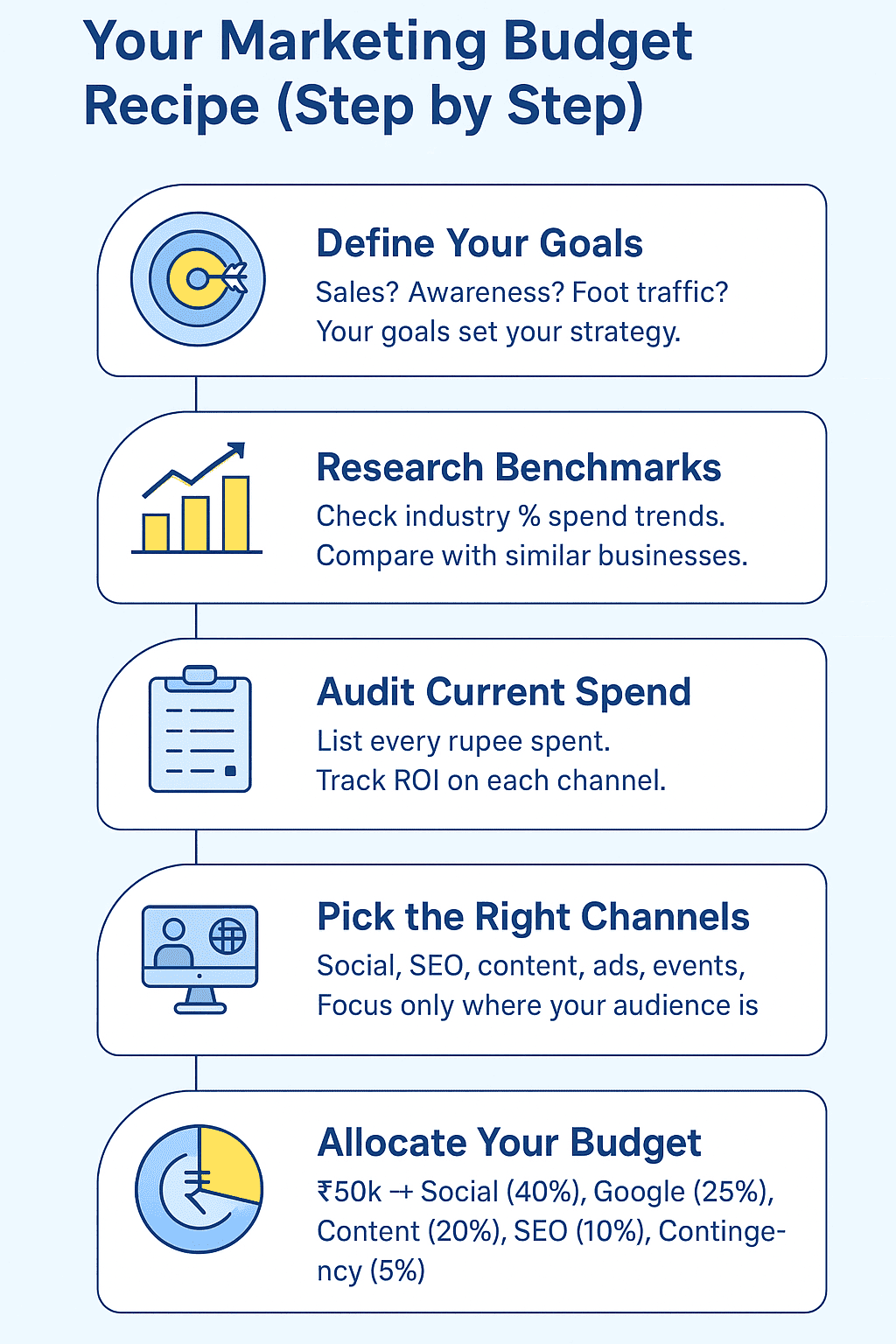Hello, budding business leader! So, you have a brilliant business idea, perhaps one that is hotter than a plate of fresh paneer tikka. You are ready to conquer the market, yet a tiny question nags you: how do you tell the world you exist without your wallet staging a protest?
Do not worry. Crafting a marketing budget is not some dark art reserved for giant corporations. Think of it as creating the perfect spice mix (masala) for your business growth. Get the proportions right, and you will have customers flocking to your door.
Let us create a marketing budget blueprint that is practical, powerful, and perfect for your small business in India.
Step-by-step marketing budget plan for small business
Understand your business goals and financial situation
Before you can decide where your money is going, you need to know where your business is going. Are you trying to launch a new product, increase online sales by 30% or get more foot traffic into your new café? Your goals will define your marketing strategy.
This is where your bookkeeping basics come in handy. A clear view of your revenue, expenses, and overall cash flow is the foundation of your budget. Without knowing your numbers, planning a budget is like trying to drive to Delhi from Mumbai without a map or fuel gauge, which is a recipe for disaster.
Research industry benchmarks and averages
You do not have to invent your budget from scratch. Look at what others in your industry are doing. While every business is unique, industry benchmarks and market trends can give you a realistic starting point. It is important to research these averages. For example, consumer-focused companies may spend a higher percentage of their revenue on marketing than business-focused companies.
If you are a new startup trying to make a splash, your percentage might need to be higher initially to build momentum. Think of it as the extra fuel required for a rocket launch.

Audit your current marketing spend and results
If you have already been spending on marketing, it is time for a little detective work. This is your business’s report card. List every single rupee you have spent. Examples include digital advertisements, content creation, search engine optimization efforts, and event costs.
Once you have your list, track the return on investment. Which channels are bringing in customers, and which are eating your cash? Modern analytics tools can help you see exactly what is working. If your Instagram advertisements are bringing in leads while your print flyers are ending up in the bin, you know where to cut back.
Identify your marketing channels and tactics
Now for the fun part. Think of your marketing channels as different bowls (katoris) in a giant thali. You need a variety of flavours to satisfy your customers. Based on your target audience, decide which channels are right for you. Some options include social media marketing for building communities or content marketing with a blog to establish you as an expert. Search Engine Optimization (SEO) holds the key to improving your presence on Google search results. You do not need to be on every platform. Choose a few that make sense for your business and focus on doing them well.
Estimate and allocate your budget per channel
Once you have your total budget and your chosen channels, start allocating funds. A crucial part of a business plan is detailing how much money you need and how you plan to use it. For example, with a monthly budget of ₹50,000, you could allocate specific amounts to different areas like social media advertising, Google Ads, and content marketing. Always include a contingency fund. This brings us to a crucial point.
Build in flexibility: Test, measure, adjust
Your marketing budget is not carved in stone; it is a living document that should evolve as your business grows. The market changes, new trends emerge, and customer behaviour evolves. You should set aside a portion of your budget as a contingency fund. Review your spending and results monthly. If your search engine optimization efforts are bringing in tons of traffic, perhaps you can allocate more funds there next month. If an advertising campaign is not performing, pause it and reinvest that money into a channel that is working. This cycle of testing, measuring, and adjusting is the key to sustainable growth.
Mini-case study: ‘KiranaWalaKart’
Let us examine how a fictional Pune-based online grocery store, ‘KiranaWalaKart’, planned and executed its successful marketing budget.
- With a monthly revenue of ₹5,00,000, they set a ₹40,000 marketing budget to increase their local orders by 25%.
- Their strategy included using hyperlocal Google Ads to target local users and WhatsApp marketing for promoting their daily deals.
- The business also invested in creating content like a recipe blog to drive valuable organic traffic from search engines.
- By carefully tracking their advertisements and web traffic, they identified that WhatsApp deals delivered the highest customer conversion rates.
- They then adjusted the following month's budget to focus more on WhatsApp, which successfully helped them achieve their growth.
Wrapping it up
Crafting a marketing budget is not about limiting your business; it is about empowering it. It is the blueprint of your dream. It is the plan that turns your ambitions into achievements. By understanding your goals, auditing your spending, and staying flexible, you can ensure every rupee you spend is working hard for your success. So go on, create that budget like a boss and watch your business thrive!
Bonus: Monthly channel allocation & performance template
To make your journey smoother, we have put together a comprehensive Monthly Channel Allocation & Performance template that you can download for free. Think of it as your recipe book for mixing the perfect marketing masala. This template will help you set your budget, allocate funds, and track your results.










